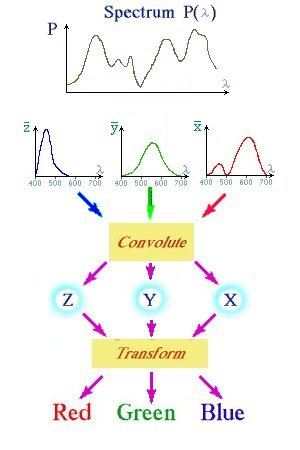
To match a color with power distribution P, the amounts of the primaries are given by the following formulae [1]:

where k for self-luminous bodies, such as CRT, is equal to 680 lumens per watt.
To transform from XYZ to RGB (with D65 white point), the matrix transform is used [3]:
[ R ] [ 3.240479
-1.537150 -0.498535 ] [ X ]
[ G ] = [ -0.969256 1.875992 0.041556 ] * [ Y ]
[ B ] [ 0.055648 -0.204043 1.057311 ] [ Z
].
The range for valid R, G, B values is [0,1]. Note, this matrix has negative coefficients. Some XYZ color may transform to R, G, B values that are negative or greater than one. This means that not all visible colors can be produced using the RGB system.